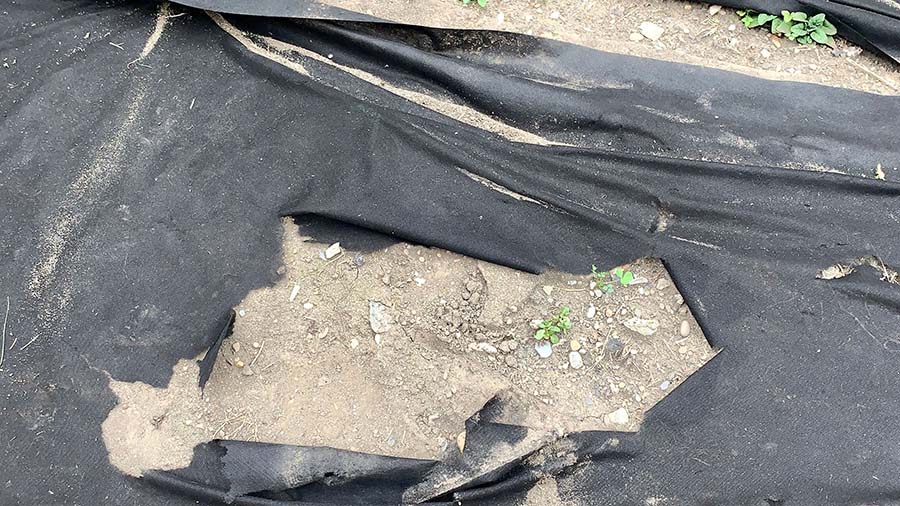Protecting and maintaining woven landscape fabric is an ongoing process, but one that rewards you with a consistently low-maintenance and beautiful garden. It’s easier than battling weeds, and a little care keeps it effective for years. Here’s a more in-depth look at maintenance and a few tips to maximize your success.
The Importance of Regular Inspection (and What to Look For)
Make it a habit to inspect your landscape fabric every few weeks, especially after strong winds or heavy foot traffic. Pay close attention to:
Tears and Punctures
Look for rips, snags, or holes in the fabric, which can become entry points for weeds. Small tears can often be repaired with heavy-duty landscape fabric repair tape, which is designed to adhere to the material. Be sure to match the tape to your material. For larger tears or where there is substantial foot traffic, consider overlapping the damaged area with a new piece of fabric and anchor it well with staples or sewing it for an even more secure repair. Apply heat to the patch edges to prevent fraying.
Shifting or Bunching
Check if the fabric has moved or bunched up anywhere. This can happen on slopes or in areas with a lot of activity. Readjust the fabric and add more staples to secure it firmly.
Loose Edges
Walk the perimeter of your installed fabric and ensure all edges are still firmly anchored with staples. Loose edges can lift and allow weeds to grow underneath. Restaple any areas that have come loose.
Plant Openings
Examine the areas around your plants where you made cuts. Ensure the fabric is still snug against the base of the plants to prevent weeds from emerging there. You may need to add more staples around these openings over time as plants grow, but take care to avoid damaging roots.
Keeping the Surface Clean: Preventing Topsoil Buildup and Weed Germination
While woven fabric stops weeds from growing through the soil, organic matter accumulating on top can create a new environment for weed seeds to sprout.
Regular Sweeping or Blowing
Use a stiff broom or a leaf blower to regularly clear away fallen leaves, pine needles, dead plant material, and soil that may have been deposited by wind or rain.
Be Mindful of Decomposing Matter
Avoid allowing thick layers of highly decomposable material to sit on the fabric for extended periods, as this will eventually break down and provide a rooting medium for shallow-rooted weeds.
Mulching Over Landscape Fabric: Best Practices
Mulch can enhance the look of your garden and help retain soil moisture, even over landscape fabric. However, improper mulching can reduce the fabric's effectiveness.
- Use well-decomposed mulch: Opt for well-aged or composted mulch, as it is less likely to contain viable weed seeds.
- Apply a thin layer: A layer of 2-3 inches of mulch is generally sufficient for aesthetic purposes and moisture retention. Avoid piling up thick layers (more than 4 inches), as this can create enough of a soil-like environment for opportunistic weeds to root.
- Replenish carefully: When adding more mulch, try not to disturb the underlying fabric.
The Impact of Chemicals
While woven geotextiles are generally inert, it's wise to exercise caution with strong chemicals.
- Avoid direct application: Don't pour concentrated fertilizers, herbicides, or other harsh chemicals directly onto the fabric. Dilute them according to instructions and apply them carefully to the soil around your plants. Fertilizers, pesticides, and other additives can often be applied through drip irrigation systems, which eliminates exposure to your weed barrier fabric and uses significantly less chemicals.
- Consider pH: While the polypropylene in slit-film geomembranes is resistant to most common soil pH levels, extreme and prolonged exposure to highly acidic or alkaline conditions could affect its long-term integrity. Monitor your soil pH and amend it as needed for your plants, avoiding direct contact of strong amendments with the fabric.
Securing Against the Elements and Activity
Strong winds and various garden activities can sometimes loosen anchoring staples
- Regular checks: Make a point to check staple security, especially after strong winds or periods of heavy activity in the garden.
- Use quality staples: Choose good quality, heavy-duty landscape fabric staples that are resistant to rust and bending. Longer staples generally provide a better grip.
- Add more staples in vulnerable areas: Vulnerable areas include on slopes, around plant openings, and along edges that are frequently disturbed, such as heavily traveled walkways,
Dealing with Fraying (Advanced Tips)
We covered the basics of securing cut edges to protect against fraying in Chapter 5. Whenever you find frayed edges or apply patches to an installed woven landscape fabric, address it as soon as possible to keep the damage from getting worse.
Looking Ahead
Now that we’ve looked at several roles woven landscape fabric can be used on your property, our final chapter will imagine some scenarios where slit-film woven landscape fabric can be used to address unique challenges.




